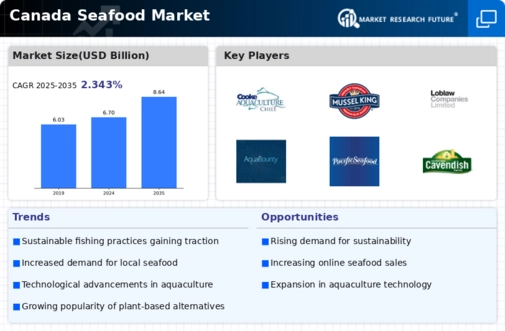Rising Consumer Demand for Seafood
The seafood market in Canada is experiencing a notable increase in consumer demand, driven by a growing awareness of the health benefits associated with seafood consumption. Recent data indicates that seafood consumption has risen by approximately 15% over the past five years, as more Canadians recognize the nutritional value of fish and shellfish. This trend is further supported by the increasing popularity of diets rich in omega-3 fatty acids, which are prevalent in various seafood products. As a result, the seafood market is likely to expand, with consumers seeking diverse options, including fresh, frozen, and processed seafood. Retailers and suppliers are responding to this demand by enhancing their product offerings, which may lead to increased competition and innovation within the seafood market.
Impact of Environmental Regulations
The seafood market in Canada is significantly influenced by stringent environmental regulations aimed at promoting sustainable fishing practices. The Canadian government has implemented various policies to protect marine ecosystems, which has led to a shift in fishing methods and practices. For instance, regulations on bycatch reduction and habitat protection are becoming more prevalent, impacting how seafood is sourced. These regulations may initially pose challenges for some operators; however, they also create opportunities for businesses that prioritize sustainability. Companies that adapt to these regulations may find themselves better positioned in the seafood market, appealing to environmentally conscious consumers and potentially gaining a competitive edge.
Growth of E-commerce in Seafood Sales
The seafood market in Canada is witnessing a transformation due to the rapid growth of e-commerce platforms. Online seafood sales have surged, with estimates suggesting a growth rate of around 20% annually. This shift is largely attributed to changing consumer preferences, as more individuals opt for the convenience of purchasing seafood online. E-commerce allows consumers to access a wider variety of seafood products, including specialty items that may not be available in local stores. As a result, traditional seafood retailers are increasingly investing in online sales channels to remain competitive. This trend is likely to reshape the seafood market, as businesses adapt to the digital landscape and enhance their logistics and distribution strategies.
Cultural Influences on Seafood Consumption
Cultural factors play a pivotal role in shaping the seafood market in Canada. The diverse population, comprising various ethnic communities, contributes to a rich tapestry of culinary preferences that often emphasize seafood. For instance, traditional dishes from Asian, Mediterranean, and Indigenous cultures frequently feature seafood as a central ingredient. This cultural diversity not only drives demand for specific seafood products but also encourages innovation in product offerings. As consumers seek authentic culinary experiences, the seafood market is likely to expand to accommodate these preferences, leading to increased variety and availability of seafood options that reflect the multicultural fabric of Canadian society.
Technological Innovations in Seafood Processing
Technological advancements are significantly impacting the seafood market in Canada, particularly in the area of processing and preservation. Innovations such as advanced freezing techniques and improved packaging solutions are enhancing the quality and shelf life of seafood products. These technologies not only help in maintaining freshness but also reduce waste, which is a critical concern in the seafood industry. Furthermore, automation in processing facilities is streamlining operations, potentially lowering production costs. As these technologies continue to evolve, they may lead to increased efficiency and competitiveness within the seafood market, allowing businesses to meet growing consumer demands while adhering to quality standards.




















Leave a Comment